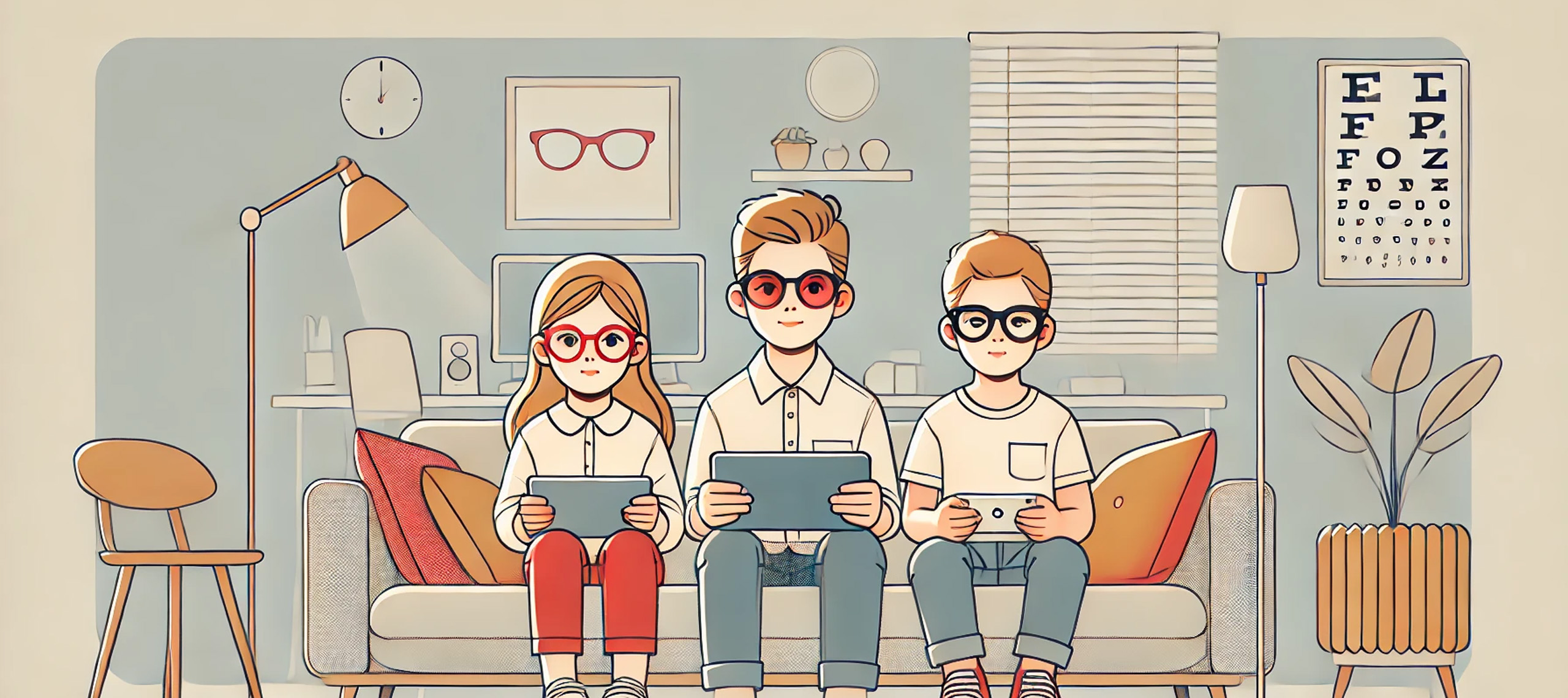Digital age and children’s vision: risks and opportunities.

⏱️ 04:30 READING TIME
In today’s digital era, devices like computers, tablets, and smartphones have become an integral part of daily life – not just for adults but for children as well. These tools are now essential for both education and leisure, but they also prompt questions about their potential impact on children’s vision and overall health. What are the main risks associated with prolonged screen exposure? Can we also find positive aspects in this rapidly evolving scenario?
The main risks to children’s visual health
Prolonged screen use can lead to “digital eye strain,” a condition marked by symptoms such as dry eyes, itching, blurred vision, and difficulty focusing. This happens when the eyes are constantly fixated on a nearby screen, overloading the eye muscles.
Moreover, myopia (nearsightedness) is on the rise among children. Hours spent focusing on digital screens, coupled with limited exposure to natural light, appear to accelerate the development of this condition. Research suggests that children who spend more time outdoors are less likely to develop myopia compared to those who stay indoors glued to screens.
Effects of screen time on overall health
The impact of digital devices isn’t limited to vision alone. Posture, sleep, and mental well-being can also suffer:
- Posture: Extended screen use often leads to slouching, which can result in neck, back, and shoulder pain.
- Sleep: Blue light emitted by devices can disrupt sleep patterns, alter circadian rhythms, and make falling asleep difficult, particularly when screens are used in the evening.
- Emotional well-being: Excessive digital stimulation can cause anxiety and restlessness, especially when screen time isn’t regulated.

How to protect children’s vision: strategies and practical tips
Prevention is the key, and regular eye check-ups are strongly recommended. Taking children for annual eye exams helps monitor their visual health. Fortunately, there are simple and effective measures to mitigate the risks associated with excessive screen use:
- The “20-20-20” Rule:
To alleviate eye strain, encourage children to follow the 20-20-20 rule. Every 20 minutes of screen use, they should look away from the screen and focus on an object about 6 meters (20 feet) away for at least 20 seconds. This allows the eyes and their muscles to relax. - Limit screen time:
Pediatricians recommend setting daily screen time limits, especially for younger children. For school-aged kids, taking frequent breaks can reduce eye strain and slow the progression of myopia. - Encourage outdoor activities:
Natural light and open spaces promote healthy visual development. Spending more time outdoors has protective effects against myopia and provides much-needed rest for eyes strained by digital devices. - Use blue light filter glasses:
Glasses with blue light-blocking lenses can help reduce the impact of blue light on children’s eyes, especially for those who spend many hours on screens. However, these glasses should not replace regular breaks. - Offer alternatives to digital devices:
Boredom is essential for children’s creative development, but in the digital age, moments of mental pause often disappear. Kids tend to turn to screens for relaxation or lack of ideas, rather than productivity. Allowing moments of boredom is crucial for time management, creativity, and independent problem-solving.
Simple household activities can also keep children away from screens and help protect their vision. Tasks like making the bed, tidying toys, or helping with chores foster a sense of responsibility and strengthen their connection with the real world – rather than the virtual world of social media.

The benefits of technology: harnessing it in a healthy way
While technology presents risks, it also offers educational and social benefits when used mindfully. Digital devices can spark curiosity and creativity, making learning more interactive and engaging. Educational games, for instance, help develop cognitive and problem-solving skills.
To maximize the advantages of technology, it’s important to find a balance. Screen time should be complemented with activities that support physical and visual development.
Teaching children responsible technology use
Helping children understand the importance of taking care of their eyes is essential for navigating the digital age healthily. Involving them in managing screen time and establishing breaks and limits together fosters a balanced relationship with technology. These habits of self-awareness and eye care will serve them well into adulthood.
Conclusion
The digital era poses significant challenges to children’s visual health, but it also offers opportunities to teach them responsible technology use for a future that will increasingly rely on it. With small adjustments and strategies, we can reduce risks and turn digital innovation into a tool for growth. It’s our responsibility to guide children on this journey, protecting their eyes and overall well-being while ensuring that technology serves them – not the other way around.

